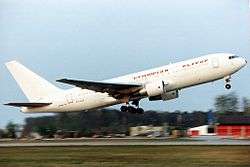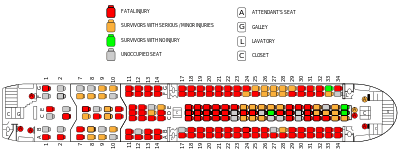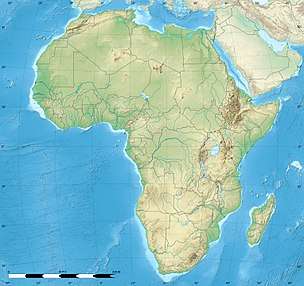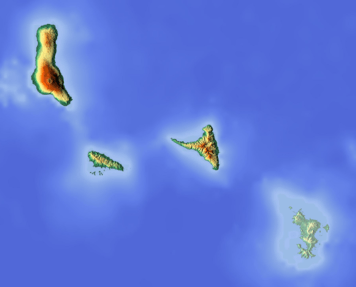Ethiopian Airlines Flight 961
Ethiopian Airlines Flight 961 was a scheduled flight serving the route Addis Ababa–Nairobi–Brazzaville–Lagos–Abidjan. On 23 November 1996, the aircraft serving the flight, a Boeing 767-200ER, was hijacked[1] en route from Addis Ababa to Nairobi[2] by three Ethiopians seeking asylum in Australia.[3] The plane crash-landed in the Indian Ocean near Grande Comore, Comoros Islands due to fuel exhaustion; 125 of the 175 passengers and crew on board, including the three hijackers, died.[3] The crash was captured on video.
 ET-AIZ, the aircraft involved in the crash, is seen here at Frankfurt am Main Airport in 1993 | |
| Hijacking | |
|---|---|
| Date | 23 November 1996 |
| Summary | Water landing due to fuel exhaustion caused by hijacking |
| Site | Grande Comore, Comoros 11°22′22″S 43°18′25″E |
| Aircraft | |
| Aircraft type | Boeing 767-260ER |
| Operator | Ethiopian Airlines |
| IATA flight No. | ET961 |
| ICAO flight No. | ETH961 |
| Call sign | ETHIOPIAN 961 |
| Registration | ET-AIZ |
| Flight origin | Bole International Airport Addis Ababa, Ethiopia |
| 1st stopover | Jomo Kenyatta Int'l Airport Nairobi, Kenya |
| 2nd stopover | Maya-Maya Airport Brazzaville, Republic of the Congo |
| Last stopover | Murtala Mohammed Int'l Airport Lagos, Nigeria |
| Destination | Port Bouet Airport Abidjan, Côte d'Ivoire |
| Occupants | 175 (including 3 hijackers) |
| Passengers | 163 (including 3 hijackers) |
| Crew | 12 |
| Fatalities | 125 (including 3 hijackers) |
| Injuries | 46 |
| Survivors | 50 |
Aircraft and crew
Aircraft
The aircraft involved in the crash was a Boeing 767-260ER, registration ET-AIZ, c/n 23916, that had its maiden flight on 17 September 1987.[4] Powered by two Pratt & Whitney JT9D-7R4E engines, it was delivered new to Ethiopian Airlines on 22 October 1987.[4][5] Except for a short period between May 1991 and February 1992 when it was leased to Air Tanzania, the airplane spent its life in the Ethiopian Airlines fleet.[4] It was nine years old at the time the incident took place.
Crew
Captain Leul Abate (42), an experienced pilot with over 11,500 total flight hours (including 4,067 hours in the Boeing 757/767), was the pilot-in-command. The first officer on the flight was Yonas Mekuria (34). He had flown more than 6,500 hours, 3,042 of them in the Boeing 757/767.[2]
Prior to the crash, Leul[lower-alpha 1] had experienced two previous hijackings.[6] The first occurred 12 April 1992 on Flight ETH574, a Boeing 727-260. Two hijackers with hand grenades demanded to be taken to Nairobi and onwards to Canada. After a five-hour standoff at Jomo Kenyatta International Airport the hijackers surrendered.[7] The second occurred on 17 March 1995, flying a Boeing 737-260. Five hijackers demanded to be taken to Libya, and the airplane was diverted to El Obeid, Sudan. There the hijackers changed their mind and wanted to fly to Sweden instead. However, the Sudanese authorities refused to refuel the aircraft, and after several hours of standoff the hijackers surrendered.[8] In both cases, the flights landed safely with nobody injured or killed.[6]
Description
Departure
The flight had been delayed in order to wait for a connecting flight. The aircraft took off at 08:09 UTC.[2]:3
Hijacking
At about 08:29 UTC,[2]:3 when the aircraft, referred to as Zulu by Ethiopian Airlines' pilots, after the last letter of its registration,[9] was still flying over Ethiopian airspace,[10] three Ethiopian men charged the cockpit and hijacked the aircraft after taking an axe and a fire extinguisher from the cockpit.[2]:1 According to a special Airdisaster.com report: "One of the men ran down the aisle toward the cockpit, shouting statements that could not be understood, and his two accomplices followed soon after." The Airdisaster report described the men as "young (mid-twenties), inexperienced, psychologically fragile, and intoxicated."[10] Ethiopian state-operated radio later identified the hijackers as two unemployed high-school graduates and a nurse; their names were Alemayehu Bekeli Belayneh, Mathias Solomon Belay, and Sultan Ali Hussein (they did not say who had which description).[11]
The men threatened to blow the plane up in flight if the pilots did not obey their demands.[2]:10 The hijackers said that there were eleven of them when in fact there were only three.[2]:4[9] After assaulting and forcing first officer Yonas Mekuria into the cabin, they made the following announcement:
Everybody should be seated, I have a bomb.
Over the intercom, they declared in Amharic, French and English that if anyone tried to interfere, they had a bomb and they would use it to blow up the plane.[2]:4[9] Authorities later determined that the purported bomb was actually a covered bottle of liquor.[12]
The hijackers demanded the plane be flown to Australia.[3] Leul tried to explain they had only taken on the fuel needed for the scheduled flight and thus could not even make a quarter of the journey, but the hijackers did not believe him.[9] One of them pointed out a statement in the airline's in-flight magazine that the maximum flying time of the 767 was 11 hours.[2]:4
Instead of flying towards Australia, the captain followed the African coastline southward. The hijackers noticed that land was still visible and forced the pilot to steer east. Leul secretly headed for the Comoro Islands, which lie midway between Madagascar and the African mainland. During this time two of the hijackers went into the cabin, with the lead hijacker (as stated in the report) staying in the cockpit.[9]
Crash landing
The plane was nearly out of fuel as it approached the island group, but the hijackers continued to ignore the captain's warnings. Out of options, Leul began to circle the area, hoping to land the plane at the Comoros' main airport. This forced Leul to land at more than 175 knots (324 km/h; 201 mph).[9]
At 11:41 UTC the right engine flamed out. The hijacker briefly exited into the cabin to talk with the other hijackers. Leul took this opportunity to make use the aircraft's public address system and made the following announcement:[2]:8
Ladies and gentlemen this is your pilot, we have run out of fuel and we are losing one engine [at] this time, and we are expecting [a] crash landing and that is all I have to say. We have lost already one engine, and I ask all passengers to react..... to the hijackers....
Hearing this, the lead hijacker returned to the cockpit and struck Leul's microphone out of his hand.[2]:8 Shortly after this, the left engine flamed out, forcing the 767 to glide. The Cockpit Voice recorder (CVR) then recorded the following (lowercase words were spoken in Amharic while words typed in uppercase were spoken in English):
Leul: "For the sake of my responsibility AT LEAST the passengers must know the condition.
Hijacker: "Descend it increase the speed further."Leul: "It doesn't have any difference. PLEASE. All the same. We are going to die. Why don't you- I thought there is no need to. For the passengers-"
End of recording
Leul's sentence was cut off as the CVR and Flight Data Recorder (FDR) both stopped recording at this point due to both engines having flamed out.[2]:17–21
Leul tried to make an emergency landing at Prince Said Ibrahim International Airport on Grande Comore, but a fight with the hijackers at the last minute caused him to lose his visual point of reference, leaving him unable to locate the airport. While still fighting with the hijackers, he tried to ditch the aircraft in shallow waters 500 yards (460 m; 1,500 ft) off Le Galawa Beach Hotel, near Mitsamiouli at the northern end of Grande Comore island. Leul attempted to land parallel with the waves instead of against the waves in an effort to smooth the landing. Seconds prior to contacting the water the aircraft was banked left some ten degrees;[13] the left engine and wingtip struck the water first. The engine acted as a scoop and struck a coral reef, slowing that side of the aircraft quickly and causing the Boeing 767 to suddenly tilt left. The rest of the aircraft then entered the water unevenly, causing it to break apart. Except for the rear part of the airframe, the broken portions of the fuselage sank rapidly.[13] Many passengers died because they inflated their life jackets in the cabin,[10][12] causing them to be trapped inside by the rising water.
Island residents and tourists, including a group of scuba divers and some French doctors on vacation, came to the aid of crash survivors.[14][9] A tourist recorded a video of ET-AIZ crashing. She said that she had begun taping because she initially believed that the 767 formed a part of an air show for tourists.[15]
Medical treatment and repatriation of bodies
Survivors were initially taken to Mitsamiouli Hospital. The crash site was less than 2 kilometres (1.2 mi; 1.1 nmi) away from this hospital. The passengers were transferred to El-Maarouf Regional Hospital Centre (Centre Hospitalier National El Maarouf) in Moroni the same day.[2]:25 The two French people who survived and 19 injured were transported to Réunion.[2] In Réunion, one of the injured died, making the death toll 125.[2] Excluding those transported to Réunion, survivors were transported to Kenya and South Africa.[2]
At the time there was no mortuary in Moroni, so cold rooms were used to store 124 bodies.[2]
Investigation
On 3 December 1996 the Direction Generale de l'Aviation Civile des Comores of the Comoros agreed to delegate the investigation of ET961 to the Ethiopian Civil Aviation Authority (ECAA).[2] The Air Accidents Investigation Branch (AAIB) analysed the flight recorders.[2]:17
Fate of the passengers and crew
The final accident report includes a listing of surviving and dead passengers and crew. All 12 crew members were Ethiopians. Six survived, including the pilot and copilot.[2]:61
The passengers originated from 36 countries.
The passenger manifest (including hijackers but not crew members) follows:
| Nationality | Number on board | Fatalities | Survivors |
|---|---|---|---|
| Austria | 1 | 1 | 0 |
| Belgium | 1 | 1 | 0 |
| Benin | 2 | 2 | 0 |
| Cameroon | 2 | 2 | 0 |
| Canada | 1 | 1 | 0 |
| Chad | 1 | 1 | 0 |
| Congo | 5 | 3 | 2 |
| Ivory Coast (Côte d'Ivoire) | 1 | 1 | 0 |
| Djibouti | 2 | 0 | 2 |
| Egypt | 1 | 1 | 0 |
| Ethiopia | 19 | 16 | 3 |
| France | 4 | 2 | 2 |
| Germany | 1 | 1 | 0 |
| Hungary | 1 | 1 | 0 |
| India | 20 | 14 | 6 |
| Israel | 8 | 7 | 1 |
| Italy | 4 | 0 | 4 |
| Japan | 2 | 1 | 1 |
| Kenya | 14 | 8 | 6 |
| South Korea | 1 | 1 | 0 |
| Lesotho | 1 | 0 | 1 |
| Liberia | 2 | 2 | 0 |
| Mali | 12 | 9 | 3 |
| Nigeria | 23 | 19 | 4 |
| Pakistan | 1 | 1 | 0 |
| Sierra Leone | 1 | 1 | 0 |
| Somalia | 1 | 1 | 0 |
| Sri Lanka | 9 | 9 | 0 |
| Sweden | 2 | 2 | 0 |
| Switzerland | 1 | 1 | 0 |
| Uganda | 1 | 0 | 1 |
| Ukraine | 4 | 1 | 3 |
| United Kingdom | 7 | 5 | 2 |
| United States | 5 | 2 | 3 |
| Yemen | 1 | 1 | 0 |
| Zaire | 1 | 1 | 0 |
| Total | 163 | 119 | 44 |

The dead passenger count includes the three hijackers.[2]:61, Of the passengers, 42 originated in Bombay, including:[16]
- 3 Americans
- 9 Nigerians
- 9 Sri Lankans
- 19 Indians
The rest of the passengers originated in Addis Ababa.
Of the 175 passengers and crew members, 125 were killed, including the three hijackers. According to the accident report, all six surviving crew members and 38 passengers received serious injuries, two passengers received minor injuries, and four passengers received no injuries.[2]:10 One passenger, an Ethiopian, was identified as a child on the manifest; this passenger was among the dead.[2]:66
Many of the passengers survived the initial crash, but they had disregarded or did not hear Leul's warning not to inflate their life jackets inside the aircraft, causing them to be pushed against the ceiling of the fuselage by the inflated life jackets when water flooded in. Unable to escape, they drowned. An estimated 60 to 80 passengers, strapped to their seats, presumably drowned.[17][18]
Leul and Yonas both survived. For his actions, Leul was awarded the Flight Safety Foundation Professionalism in Flight Safety Award.[19]
Notable passengers
Among those killed was Mohamed Amin, a wartime photojournalist and publisher of Selamta, Ethiopian Airlines' in-flight magazine.[20] He was believed to be standing near the entrance to the cockpit arguing or negotiating with the hijacker presumed to be guarding the cockpit during the final moments of the flight. Brian Tetley, Amin's colleague, also died.[21]
CIA officer Leslianne Shedd, who was posted to Ethiopia, died in the crash. At the CIA's 2012 Annual Memorial Ceremony to Honor Fallen Colleagues, the Agency recalled survivors of the crash telling the CIA that "Leslianne...spent her final moments comforting those around her."[22]
Franklin Huddle, the U.S. Consul General of Bombay at the time, and his wife Chanya "Pom" Huddle both survived the crash.[23] Huddle said that he chose to fly on Ethiopian Airlines while planning a safari trip to Kenya because of the airline's reputation; it was one of the few airlines in Africa to have Federal Aviation Administration certification. Huddle wanted a flight during the day, reasoning that flying during the day was "safer."[9] He credits his and his wife's survival to a last-minute upgrade to business class.[24]
Other passengers who died on the aircraft included Lt.Gen.(Ret.) Antal Annus, the Hungarian ambassador to Kenya[25] and a French foreign ministry official.[26]
Maps
 Addis Ababa Nairobi Crash site Brazzaville Lagos Abidjan Location of the crash and the airports |
 Crash site Crash site in the Comoros |
Aftermath
A memorial service was held in Galawa on 30 November 1996.[2]
The incident has become a well-known hijacking because of the videotape.[15] This was one of very few large airliner water landings, and was the first hijacked water landing. Both the captain and first officer of the flight received aviation awards, and both continued to fly for Ethiopian Airlines.[9]
In the media
The crash was featured in three episodes of Mayday (Air Emergency, Air Crash Investigation, Air Disasters (Smithsonian Channel)). The first appearance was in season 1 to explain what might have happened if Air Transat Flight 236 had ditched instead of landing in a nearby airport. In season 3, an episode ("Ocean Landing") covered the events of Flight 961 in detail. Most recently, it featured in the season 10 episode covering US Airways Flight 1549, to explain the risks of that crew's decision to ditch in the Hudson River. It was also featured in a 2010 episode of the Biography Channel series I Survived..., in which a survivor told his story of what happened on the plane.[27]
See also
- Air Canada Flight 143
- Air Transat Flight 236
- US Airways Flight 1549
- Guangzhou aircraft collision
- Ethiopian Airlines accidents and incidents
- List of accidents and incidents involving commercial aircraft
- List of airline flights that required gliding
Notes
- Ethiopian names do not have family names, so Ethiopian people are addressed by their given names.
References
- "1996 spawns worst-ever accident totals". Flightglobal. Flight International. 15 January 1997. Archived from the original on 24 May 2012. Retrieved 24 May 2012.
The 23 November 1996, hijack of an Ethiopian Airlines 767 resulted in the death of 128 people when the pilots were forced to ditch the aircraft near the Comoros Islands.
- "Ethiopian Airlines B767(ET-AIZ) Aircraft Accident in the Federal Islamic Republic of the Comoros, in the Indian Ocean on November 23, 1996" (PDF). Ethiopian Civil Aviation Authority. 4 May 1998. Archived from the original (PDF) on 27 March 2014.
- Hijacking description at the Aviation Safety Network. Retrieved on 24 May 2011.
- "Boeing 767 – MSN 23916". Airfleets.net. Archived from the original on 22 February 2014. Retrieved 3 January 2012.
- "Accident information : Boeing 767 Ethiopian Airlines ET-AIZ". Airfleets.net. Archived from the original on 22 February 2014. Retrieved 3 January 2012.
- Mayday series, season 3, episode 13: African Hijack (Ocean Landing)
- Hijacking description for ETH574 at the Aviation Safety Network. Retrieved on 19 March 2020.
- Hijacking description for 17 March 1995 at the Aviation Safety Network. Retrieved on 19 March 2020.
- "African Hijack"/"Ocean Landing," Mayday series', season 3, episode 13
- "Special Report: Ethiopian Airlines Flight 961". Airdisaster.com. Archived from the original on 23 September 2012. Retrieved 23 September 2012.
- "Government Names Ethiopian Airlines Hijackers". Minnesota Daily. 5 December 1996. Archived from the original on 24 May 2012. Retrieved 24 May 2012.
Two unemployed high school graduates and a nurse were identified Wednesday as the hijackers of a jet that crashed off the Comoros Islands last month... The Ethiopian men were identified as Alemayehu Bekeli Belayneh, Mathias Solomon Belay and Sultan Ali Hussein. Officials did not say which was the nurse or how old they were.
- Blomfield, Adrian (25 January 2010). "Beirut: 90 feared dead as Ethiopian Airlines plane crashes into Mediterranean". The Daily Telegraph. Archived from the original on 24 May 2012. Retrieved 24 May 2012.
- "Ethiopian hijacking results in worst-ever fatalities". Flight International: 8. 4–10 December 1996. Archived from the original on 1 September 2012.
- Lendon, Brad (16 January 2009). "Previous jet ditchings yielded survival lessons". CNN. Archived from the original on 18 January 2012. Retrieved 24 May 2012.
- "Honeymooners capture dramatic images of Ethiopian jet crash". CNN. 26 November 1996. Archived from the original on 17 January 1999.
- McNeil Jr., Donald G. (25 November 1996). "Terror in the Air, and Frantic Rescue From the Sea". The New York Times. Archived from the original on 8 January 2014.
- "Plane is hijacked; crashes in Ocean off east Africa". The New York Times. 24 November 1996. Archived from the original on 4 March 2014. Archived 25 February 2014 at the Wayback Machine
- "Ethiopian airline crash kills at least 50". Moroni: CNN. 23 November 1996. Archived from the original on 21 September 2012. Retrieved 21 September 2012.
- "Flight Safety Foundation Award in Flight Professionalism". Flight Safety Foundation. Archived from the original on 21 May 2013. Retrieved 8 October 2009.
- Episode Seven, Mo & Me: Part 1, Part 2
- "Mohamed Amin, 53, Camera Eye During the Famine in Ethiopia". The New York Times. 26 November 1996. Archived from the original on 1 September 2012. Retrieved 1 September 2012.
- "CIA Holds Annual Memorial Ceremony to Honor Fallen Colleagues" (Press release). Central Intelligence Agency. 22 May 2012. Archived from the original on 25 May 2012. Retrieved 25 May 2012.
Leslianne Shedd was serving a highly successful tour in Ethiopia when, in November 1996, hijackers forced down her plane over the Indian Ocean, killing over 125 people. Survivors of that flight tell us that Leslianne—an outstanding young woman—spent her final moments comforting those around her.
- "'I Thought I Had Finished My Life' – Tale Depicts Drunken Abductors Who Fought With Pilot – Survivors Tell of Terror As Jetliner Tumbles Across Ocean's Surface". The Seattle Times. 25 November 1996. Archived from the original on 25 September 2013.
- "No Resting Place," (Archive) Brown University Alumni Magazine
- Cohen, Tom (25 November 1995). "I was sinking fast . . . I had to get out". The Independent. Associated Press.
- "Bizarre ordeal recounted in Ethiopian Airlines crash". Moroni: CNN. 24 November 1996. Archived from the original on 5 February 2007. Retrieved 25 August 2012.
- "37 – Franklin/Jeff and Frank/Connie". Archived from the original on 2 September 2012. Retrieved 23 November 2018.
External links
| Wikimedia Commons has media related to Ethiopian Airlines Flight 961. |
- Final Incident Report (Archive Alt archive) - Ethiopian Civil Aviation Authority - Includes list of passengers, surviving and deceased
- "Milestones." (Archive) TIME. 9 December 1996. – Announcement of deaths of Mohammed Amin and Brian Tetley
- "Rescuers continue search for victims of hijacked plane." (Archive) Associated Press at the Lubbock Avalanche-Journal. 1996.
- The Hijacking of Ethiopian Airlines Flight 961 (Criminal Acts Against Civil Aviation – 1996, FAA) (Archive Alt archive)
- Video clip of the crash on YouTube